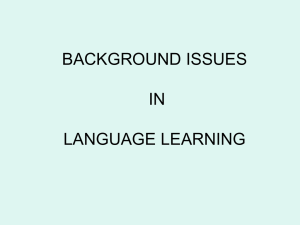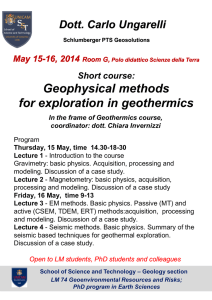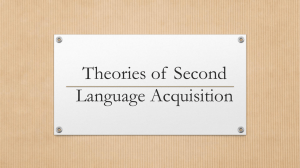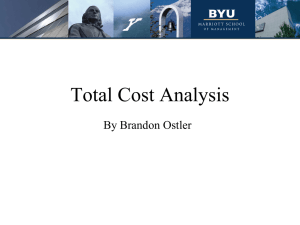ppt
advertisement
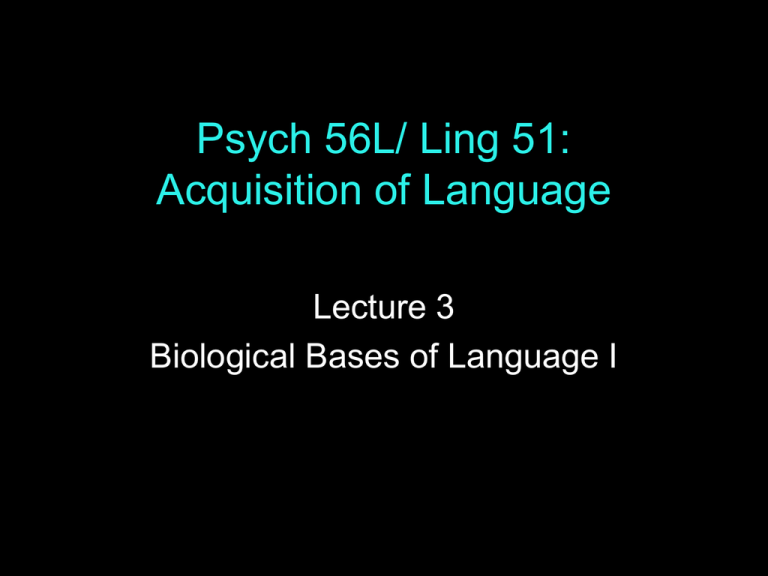
Psych 56L/ Ling 51: Acquisition of Language Lecture 3 Biological Bases of Language I Announcements Review questions for biological bases of languages available Be working on HW1 (due 1/20/11) Language as a Human Universal Language as a Human Instinct Fish pretty much always swim. Birds pretty much always fly. Humans pretty much always….talk. More than culture Language is more than simply a cultural habit that one generation copies from previous ones. If there is no language model to learn from, humans will spontaneously create language. pigdins & creoles the case of Nicaraguan Sign Language Pidgins Pidgin: language created by adults from different language backgrounds who need to communicate with each other Example: Hawaiian Pidgin English: created by immigrant workers from Japan, Korea, and the Phillipines who worked for English speakers Ifu laik meiki, mo beta make time, mani no kaen hapai. If like make, more better die time, money no can carry. “If you want to build (a temple), you should do it before you die - you can’t take it with you!” Pidgins Pidgin: language created by adults from different language backgrounds who need to communicate with each other Another example: Russenorsk: from Russian and Norwegian fishermen who had to communicate with each other (More than 100 pidgin languages currently in use) Creoles Pidgins tend to be structurally simple (often just nouns and verbs). However, when children born into a community where a pidgin is the only language acquire that pidgin as their native language, they create a creole. Creoles are grammatically more complex, containing structures that are not in the pidgin language the children had as a model such as consistent word order, tense marking, and multi-clause sentences. Creoles often share the same features. http://en.wikipedia.org/wiki/Syntactic_similarities_of_creoles#Syntactic_simila rities Put simply: children add something that wasn’t already there! Derek Bickerton (Scientific American, July 1983) What creoles tell us (1) The existence of language in a community does not depend on someone importing a language for a community to learn. (Vocabulary may be borrowed, grammar seems not to be.) (2) When children acquire language, they sometimes add something extra, which is sometimes thought to be universal to human languages and part of children’s innate endowment for language. (3) Creoles tend to share the same features - which suggests human minds may tend to construct languages the same way. From pidgin to creole: Nicaraguan Sign Language In 1978, the Nicaraguan government opened the nation’s first public schools for the deaf. The deaf children who entered had no common sign language, but did have their own individual home sign systems. Example English home signer: http://goldin-meadow-lab.uchicago.edu/Images/shovel.mov Once the children were in contact with each other, a new common sign language emerged: Nicaraguan Sign Language. http://www.pbs.org/wgbh/evolution/library/07/2/l_072_04.html From pidgin to creole: Nicaraguan Sign Language Ann Senghas (Senghas & Coppola 2001) studied the language of children who arrived to the school at a young age vs. children who arrived when they were older. Language of younger children: structurally complex (more like creole) Language of older children: structurally simpler (more like pidgin) Inflection: He likes me. (as opposed to “he like me”) Agreement: He is smiling. (as opposed to “he are smiling”) From pidgin to creole: Nicaraguan Sign Language Use of spatial modification: if two signs are made in the same spatial location, it indicates that one sign modifies the other (ex: “tall” in same location as “king” = “tall king” Language of younger children: more spatial modification (the younger they were, the more they used it) Language of older children: less spatial modification From pidgin to creole: Nicaraguan Sign Language Implication: (young) children are the driving force of language creation here; they are the innovators and the ones who retain the more complex structures that result from these innovations Language Bioprogram Hypothesis Proposed by Derek Bickerton: the capacity for language creation seen in creolization and the development of NSL is the same capacity that underlies language acquisition. Humans have an innate core knowledge about the structural properties human languages have. (domain-specific knowledge) In accord with the generativist approach to language acquisition. Language Bioprogram Hypothesis Proposed by Derek Bickerton: the capacity for language creation seen in creolization and the development of NSL is the same capacity that underlies language acquisition. But that knowledge may not be languagespecific! It could be statistical learning or pattern analysis abilities. (domain-general knowledge) Some support from Hudsom-Kam & Newport (2005): children given inconsistent input make it more regular; adults given inconsistent input match the inconsistency Elizabeth Bates The Critical Period Hypothesis Critical & sensitive periods “critical period for language” = biologically determined period during which language acquisition must occur in order for language to be learned fully and correctly Other biologically determined deadlines: - imprinting: chicks & ducklings follow first thing they see forever (it’s likely their mommy) - visual cells in humans: if cells for both eyes don’t receive visual input during the first year or so of life, they lose the ability to respond to visual input “sensitive period”: biologically determined period during which learning must occur for development to happen correctly, but development can still occur partially after this period Critical & sensitive periods How do we test for a critical period for language acquisition? Critical & sensitive periods How do we test for a critical period for language acquisition? Ideal experiment: deprive children of all linguistic input during the purported critical period and see how language development occurs. Problem: ideal experiment isn’t so ideal ethically or logistically Critical & sensitive periods How do we test for a critical period for language acquisition? Some historical cases that have unintentionally provided lack of linguistic input to children: “wild children”: like Victor of Aveyron Problem: the lack of language may be due to other reasons Critical & sensitive periods How do we test for a critical period for language acquisition? One success story for lack of linguistic input with a young child: Isabelle 1930s: 6-year-old Isabelle discovered hidden away in a dark room with a deafmute mother as her only contact. She was taught to speak and by age 8, appeared to be normal. Potential implication: Isabelle discovered before critical period was over. Critical & sensitive periods How do we test for a critical period for language acquisition? A more thorough study: Genie Critical & sensitive periods How do we test for a critical period for language acquisition? A more thorough study: Genie 1970s: 13-year-old Genie brought by her mother to social services after escaping mentally ill father; until mother’s escape, had no language input (and very horrific living conditions) By age 17, she had a 5-year-old’s vocabulary, and could express meanings by combining words together. Critical & sensitive periods How do we test for a critical period for language acquisition? A more thorough study: Genie However…syntactic skills lagged far behind - deficient in both production and comprehension. “Mama wash hair in sink.” “At school scratch face.” “I want Curtiss play piano.” “Man motorcycle have.” “Like go ride yellow school bus.” “Father take piece wood. Hit. Cry.” “Applesauce buy store” “Father hit Genie cry long time ago.” Dichotic listening tasks showed language was a righthemisphere activity for her (while it’s a left-hemisphere activity for most adults). Critical & sensitive periods How do we test for a critical period for language acquisition? A more thorough study: Genie Potential Implication: Genie discovered after critical period was over. However, Genie may have had other cognitive disabilities… Critical & sensitive periods How do we test for a critical period for language acquisition? Lenneberg (1967): “the only safe conclusions to be drawn from the multitude of reports is life in dark closets, wolves’ dens, forests, or sadistic parents’ backyards is not conducive to good health or normal development” Critical & sensitive periods How do we test for a critical period for language acquisition? Another study: Chelsea (Curtiss 1988) Family background: A partially deaf woman incorrectly diagnosed as “retarded”. From a loving home. Discovered at age 31, and fitted with hearing aids Outcome: Learned a large vocabulary, but syntax and morphology worse than Genie. Critical & sensitive periods How do we test for a critical period for language acquisition? Another study: Chelsea (Curtiss 1988) Sample speech from Chelsea: (1)The small a the hat (2) Orange Tim car in (3) I Wanda be drive come (4) Breakfast eating girl (5) They are is car in the Tim Critical & sensitive periods How do we test for a critical period for language acquisition? Late acquisition of sign language (ASL): deaf-of-hearing children whose parents don’t know sign language. Children are eventually exposed to sign language when they encounter other deaf children. Good: individuals have normal early childhood experience, except for lack of language input Critical & sensitive periods How do we test for a critical period for language acquisition? If critical period is true, children who learn from infancy should be better than children who learned later - this is what Newport (1990) found. Children who were 4-6 when first exposed were far superior in their sign language ability to children who were exposed after age 12. Critical & sensitive periods How do we test for a critical period for language acquisition? Late acquisition of sign language (ASL): deaf-of-hearing children whose parents don’t know sign language. Children are eventually exposed to sign language when they encounter other deaf children. Also important: not just about how long sign language speakers had known the language. Speakers who had been signing for more than 30 years showed this same difference: those exposed younger were far superior in their language skills to those exposed when they were older. Critical & sensitive periods How do we test for a critical period for language acquisition? Look at second language learning. Why? Children who learn a second language when they are young often become indistinguishable from their native-born peers. Critical & sensitive periods How do we test for a critical period for language acquisition? Testing age differences in second language acquisition: - Oyama (1976): testing Italian immigrants learning English age of arrival was better predictor of accent than how many years the immigrant had been speaking English - Oyama (1978): age of arrival was better predictor of comprehension than number of years speaking the language (not just about motor skill learning ability) Critical & sensitive periods How do we test for a critical period for language acquisition? Testing age differences in second language acquisition: Johnson & Newport (1989): testing grammatical competency of Chinese & Korean natives living in the US Heard recorded voices speaking sentences, and had to judge whether they were correct or not. “The farmer bought two pig at the market.” “Tom is reading book in bathtub.” Second-language proficiency dependent on age of initial language exposure (even with same number of years of exposure total) Second-language proficiency dependent on age of initial language exposure Morphology: e.g. verb agreement in production (birth on) Tom is/*are reading book in bathtub (4-6 yrs on) (12 yrs on) Age of Initial Language Exposure Second-language proficiency dependent on age of initial language exposure – but not all aspects are dependent Basic word order: SVO Subject Verb Object Ex: “Penguins like fish.” As opposed to “Fish penguins like” (Object Subject Verb) birth on (4-6 yrs on) (12 yrs on) Age of initial exposure Before and after the critical period (sometimes called “maturation”) During Maturation Decline in ability with maturation. After Maturation No relationship between Age of Arrival and Test Score Some Evidence for Critical Period Johnson & Newport also found that performance was not correlated with: Formal instruction in English Amount of initial exposure to English Reported motivation to learn English Self-consciousness in English Identification with American culture Sum Up: Critical Period Language learning is comparatively effortless before puberty, extremely effortful after Applies to both first and second language learning Applies to spoken and signed languages Critical periods similar to other biologicallyprogrammed abilities in humans and other species Critical vs. sensitive, revisited If there is a truly a critical period of language acquisition, people learning language after this period should not succeed very well at all while people within the critical period should do very well. Expectation: discontinuous function of performance critical period language acquisition performance age Critical vs. sensitive, revisited However, more recent experimental evidence (Hakuta, Bialystok, & Wiley 2003) suggests that there is a smoother drop-off, and also a relation to education-level. (support for sensitive period) So why are younger children better? “Less is more” hypothesis: Newport 1991 Children can remember less than adults (and have other cognitive limitations, like less attention). Perhaps language is actually easier to figure out if the input is limited to smaller chunks. Adults remember more and can store longer chunks, which makes their analytical task harder. Studies supporting a limitation on children’s input leading to better learning performance: Pearl, Goldwater, & Steyvers 2010, Pearl 2009, Pearl & Lidz 2009, Pearl 2008, Pearl & Weinberg 2007, Dresher 1999, Lightfoot 1999, Lightfoot 1991 So why are younger children better? Some experimental support for the utility of “Less is more” when learning a foreign language as an adult: Chin & Kersten (2010) Adults learning French over two one-hour sessions - full sentences vs. small phrases that incrementally increased length to full sentences (to simulate children’s steadily expanding processing abilities) Adults learning incrementally outperformed adults learning from full sentences on language proficiency tests of vocabulary and grammar. Questions? You should be able to answer up through question (13) of the bio bases review sheet, and up through question (3) on the homework.


